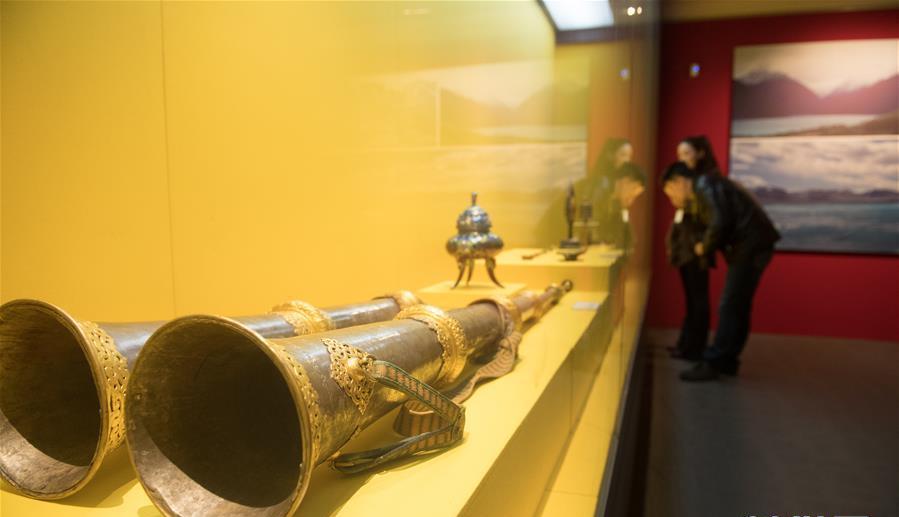Women's rising role in traditional Tibetan medicine
Tashi Tso has to change into three different pairs of shoes a day: high heels before entering the office, canvas shoes at work and white rubber soles in the manufacturing room.
She works at the pharmaceutical department of Qinghai provincial hospital of Tibetan medicine in northwest China, and the shoe changing is necessary to meet national hygiene standards.
"I love my job and am thrilled to be in an industry that was once under male dominance," she said. [ For thousands of years, knowledge of and treatment with Tibetan medicine were passed down in monasteries, and the best doctors were often monks. Women rarely had the chance to learn medicine, and their roles were restricted to household chores and raising children.
As one of China's most influential medical subjects, Tibetan medicine has been used to cure aches and ailments for over 3,800 years. It draws on traditional Chinese, Indian and Arab medicine and uses herbs, minerals and sometimes insects and animal parts.
China has intensified measures to support the development of Tibetan medicine. An innovation platform of Tibetan medicine jointly built by Beijing, Tibet, Gansu and Qinghai was recently launched. In Qinghai, a program supporting the development of Tibetan medicine was launched in December.
Fifteen therapies and practices of Tibetan medicine have been listed as national intangible cultural heritage, and the output of such medicine reached 2,300 tonnes, worth 1.5 billion yuan (around 234 million U.S. dollars) in 2016.
Due to government support and the fast development of Tibetan medicine, females are gradually breaking male dominance.
Women make up half of the physicians at the Tibetan Hospital in Lhasa, capital of Tibet. Of the graduates of Qinghai University's School of Tibetan Medicine each year, half are female, according to Tencho with Qinghai University.
Now, both men and women can learn Tibetan medicine in colleges in Qinghai, Tibet, Gansu and Sichuan, according to Dorje with Qinghai Provincial Hospital of Tibetan Medicine.
"Women are more patient and careful in manufacturing process such as making pills, pulverizing and quality control," said Tashi Tso. "Of the 51 medical staff at my department, 26 are female."
Tashi Tso was among the first batch of students enrolled in the Tibetan medicine school of Qinghai University in 2011.
"Not only did we learn the basic theories of Tibetan medicine and distinguish medical materials in the mountains with our teachers, but we also received lessons on Western medicine, including anatomy," she said.
Tibetan medicine pharmaceuticals have introduced a lot of modern equipment now, and Tibetan medicine has developed to be interdisciplinary, she added.
"It is meritorious that the medicine can help more people in the future," said a female doctor at the same hospital as Tashi Tso.
Your Comment
Name E-mailRelated News
-
;
-
-

-
Cultural relic treasures from Tibet displayed in East China
117 pieces of cultural relic treasures from southwest China’s Tibet were recently displayed in the West Lake Gallery in Hangzhou, East China’s Zhejiang Province.
-
-
-

-
Shanghai to send 1.1 mln tourists to Tibet
Shanghai will send 1.1 million tourists to Tibet in the next three years as part of an action plan to aid the development of the remote southwestern region.
-
-
-

-
Large women's and children's hospital to open in 2019 in Tibet
A large women's and children's hospital in Tibet autonomous region is expected to be put into operation in 2019, according to the Tibet health and family planning commission.
-
Based in Lhasa, Tibet Vista is a Tibet travel agency that specialized in Tibet permit, and Tibet tours for both private and group travelers at a local price!
•4 Days Lhasa City Group Tour from USD 460 •8 Days Everest Base Camp Group Tour from USD 850 •15 Days Mt.Kailash Group Tour from USD 1780 •2016 Tibet Train Tours from Beijing, Shanghai, Chengdu, Xining,etc










